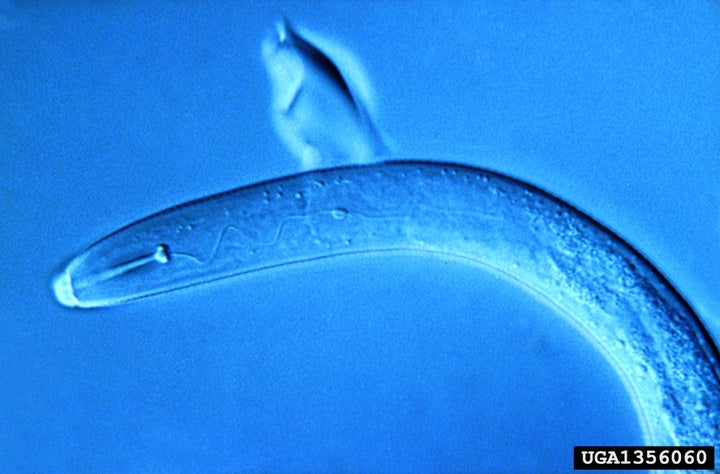
When I say I'm a neurobiologist who studies how parasitic worms use smell to find animals to infect, the response I usually get is, "Parasitic worms can smell?" Yes, many parasitic worms sense a wide variety of odors. How exactly they use odors to search for hosts is a question I'm working to answer.
The most well-studied parasitic worms are nematodes, which are a type of roundworm. There are many species of parasitic nematodes, and different species infect different hosts: some infect humans, some infect other animals and some infect plants. In many parts of the world, human-parasitic nematodes are a major cause of human disease. In some regions of Africa, over half of the population is estimated to be infected with at least one species of parasitic nematode.
Parasitic nematode infections also occur in the U.S. The most common human-parasitic nematode in the U.S. is the pinworm, which infects about 42 million people nationwide, many of them children.
Chronic infection with intestinal nematodes can cause anemia, loss of appetite, gastrointestinal distress and, in some cases, even death. In children, nematode infection can also stunt growth and cause long-lasting cognitive impairment. Although drugs can be used to treat nematode infection, reinfection rates are high and drug resistance is a concern. In addition, parasitic nematodes of livestock and crops cause billions of dollars in economic losses each year. New strategies for preventing nematode infections are needed.
Parasitic nematodes use different strategies for host infection. Some infect when eggs or larvae are ingested in contaminated water or undercooked food. Passively ingested species include the widely prevalent roundworm Ascaris lumbricoides, as well as Trichinella spiralis, the worm that causes trichinosis and that can be acquired by eating undercooked pork or wild game. Other species infect by skin penetration, typically between the toes of people walking barefoot through contaminated soil. Skin-penetrating nematodes include the threadworm Strongyloides stercoralis and human hookworm.
How do skin-penetrating nematodes find your feet as you walk barefoot through soil? One important sensory cue is heat; a human foot is much warmer than the surrounding soil, so they migrate toward a heat source. Sodium chloride is also an attractant for some nematodes. However, heat and salt are very general sensory cues. They might help a parasite distinguish a mammal from a non-mammal, but they are unlikely to help a parasite distinguish a human from a rat. Yet most mammalian-parasitic nematodes can infect only a few animal species -- for example, S. stercoralis infects humans but not rats, while the closely related species S. ratti infects rats but not humans -- suggesting that more species-specific chemicals are used by parasitic nematodes to distinguish hosts from non-hosts.
We know what some of these specific chemicals are, although the picture is far from complete. One such chemical is urocanic acid, found in mammalian skin and urine. Urocanic acid was found by Gerhard Schad's lab at the University of Pennsylvania to be a strong attractant for S. stercoralis. In preliminary experiments, my lab has also identified a number of other human skin odors that attract S. stercoralis, suggesting that it uses general mammalian cues (heat, salt) in combination with human-specific odors for locating human feet. Whether other human-parasitic nematodes use the same odors for locating humans is a question we are investigating.
So far I've talked about harmful nematode parasites, but some parasitic nematodes are actually beneficial to humans. Entomopathogenic nematodes (EPNs) infect and kill insects, including many agricultural pests, and are used throughout the world as safe alternatives to chemical pesticides. One EPN species is a cricket parasite that is used very effectively as a biocontrol agent for mole crickets, a major pest of golf courses.
Like mammalian-parasitic nematodes, EPNs use odors to locate hosts. We and others have shown that EPNs are attracted to carbon dioxide (CO2) as well as a wide array of insect odors. We have also shown that CO2 is an essential host cue for EPNs: attraction to insects is greatly reduced or even eliminated in the absence of CO2.
EPNs are also attracted to odors released by insect-damaged plants as a defense against predation. For example, Ted Turlings' lab at the University of Neuchâtel in Switzerland showed that when maize is attacked by the Western corn rootworm, its roots release an odor which attracts an EPN that parasitizes the rootworm. A better understanding of how EPNs respond to insect and plant odors could be useful in enhancing their efficacy as biocontrol agents.
Although we have learned a lot about how parasitic nematodes smell hosts, there is still a lot we don't know. Through our research, we hope to gain a better understanding of which odors attract parasitic nematodes to hosts, and how odor preferences differ among species that infect different hosts (humans vs. rats) or that use different strategies for infection (passive ingestion vs. skin penetration). We also hope to identify the neural circuits and molecular pathways that underlie the host-seeking behaviors of parasitic nematodes. A better understanding of parasitic nematodes may lead to the development of traps or other novel strategies for preventing nematode infections.